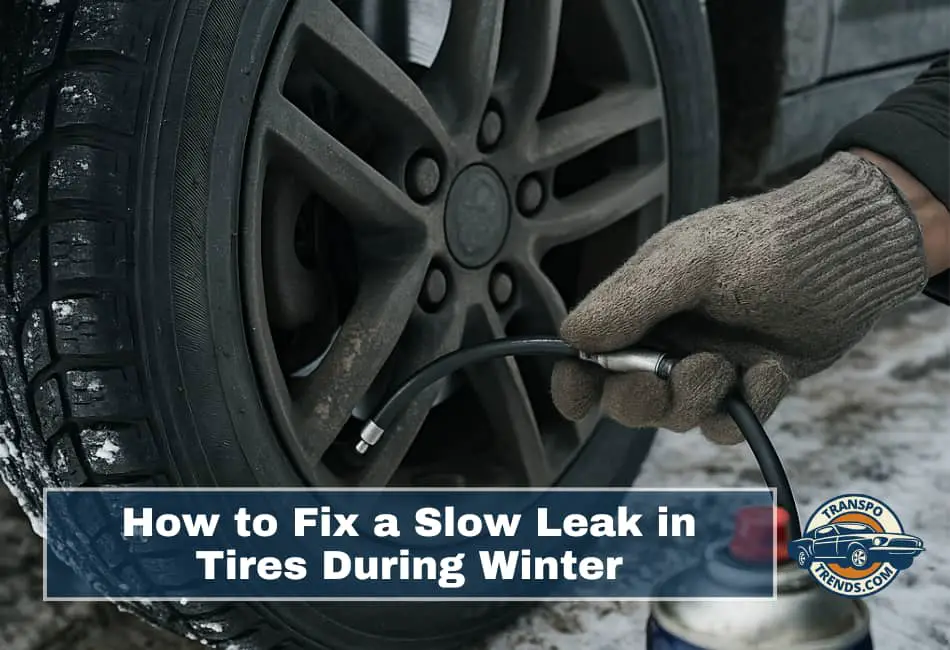Winter’s icy grip can transform the road into a labyrinth of snow, slush, and hidden hazards, making every drive feel like a test of preparation and caution.
A slow tire leak—where air gradually escapes—might seem like a minor inconvenience, but in freezing conditions, it can quickly turn a routine drive into a nerve-wracking ordeal.
Especially when the cold weather naturally lowers tire pressure, masking the problem.
A slow leak might seem small, but on icy roads, it can mean the difference between having control or facing catastrophe.
This guide will walk you through the process of identifying, fixing, and preventing slow tire leaks in winter conditions, addressing the unique challenges posed by cold weather.
With insights from expert sources and real-world experiences, this step-by-step approach will help you maintain your tires and ensure your peace of mind during winter driving.
Whether you are navigating blizzards in Minnesota or occasional snow in milder climates, these five essential steps will help you deal with slow leaks confidently.
Understanding Slow Leaks in Winter
A slow tire leak occurs when air escapes gradually, often unnoticed until the tire pressure drops significantly.
In winter, this problem is compounded by cold temperatures, which cause the air inside your tires to contract, lowering pressure by approximately 1 PSI for every 10-degree Fahrenheit drop.
This natural pressure loss can make it difficult to detect a leak, as the temperature-related pressure drop often masks it.
Slow leaks can lead to uneven tread wear, reduced fuel efficiency, and a higher risk of tire blowouts, especially on slippery winter roads.
According to Les Schwab, addressing leaks promptly is vital for maintaining traction and ensuring safety. By understanding and dealing with slow leaks early, you can avoid unnecessary risks on the road.
Step 1: Identify the Slow Leak
The first step is to confirm the presence of a slow leak. This can be particularly tricky in winter when temperature fluctuations naturally cause tire pressure to drop.
How to Detect a Leak:
Monitor Tire Pressure: Check your tire pressure at least once a month using a reliable tire pressure gauge when the tires are cold (before driving). Compare the readings to the recommended PSI listed on your vehicle’s placard, usually located on the driver’s side door jamb. A drop of 1-3 PSI beyond the natural temperature-related loss indicates the presence of a slow leak.
Observe Handling and TPMS: If your vehicle feels sluggish, pulls to one side, or the Tire Pressure Monitoring System (TPMS) light comes on, a leak is likely.
Use the Soapy Water Test: Mix dish soap with water in a spray bottle and apply it to the tire’s tread, sidewall, valve stem, and bead (where the tire meets the rim). Look for bubbles or foam, which indicate air escaping. Allow the mixture to sit for a few minutes, as slow leaks might produce subtle signs.
Winter-Specific Considerations:
Road salt can corrode valve stems, particularly on aluminum wheels, leading to leaks. Cold temperatures can also weaken the bead seal between the tire and rim, especially if debris is trapped.
| Detection Method | Description | Winter Relevance |
|---|---|---|
| Tire Pressure Check | Use a gauge monthly and compare PSI | Helps distinguish between natural pressure drop and leaks |
| TPMS Monitoring | Watch for warning light or handling issues | Critical for safety, especially in winter |
| Soapy Water Test | Spray tire to find bubbles or foam | Check valve stem for salt corrosion |
Step 2: Understand Common Causes in Winter
Slow leaks can stem from various causes, many of which are more common in winter due to cold temperatures and road conditions.
Common Causes:
- Punctures: Nails, screws, or other debris hidden under snow can lodge into the tread, causing gradual air loss. This is particularly common in urban areas or on poorly maintained winter roads.
- Valve Stem Corrosion: Road salt accelerates corrosion around the valve stem, particularly on aluminum wheels, which can lead to slow leaks.
- Bead Seal Issues: The bead, where the tire meets the rim, can lose its seal due to temperature fluctuations, debris, or corrosion, especially in older wheels.
- Sidewall or Shoulder Damage: Cold weather can make tire rubber brittle, increasing the likelihood of cracks or cuts in the sidewall or shoulder of the tire. These types of damage are unrepairable and require tire replacement.
Winter’s Impact:
Cold temperatures reduce tire rubber flexibility, making punctures harder to detect and repairs more challenging. Salt and debris from winter roads can worsen valve stem and bead issues, as noted by Tires Plus. Regular inspections are crucial to catch these issues early.
| Cause | Winter Impact | Likelihood |
|---|---|---|
| Punctures | Hidden by snow, common in urban areas | High |
| Valve Stem Corrosion | Accelerated by road salt | High |
| Bead Seal Issues | Worsened by cold and debris | Moderate |
| Sidewall Damage | Brittle rubber in cold temperatures | Moderate |
Step 3: DIY Fixes for Slow Leaks
If you’re comfortable with basic tire maintenance, you can attempt to fix some slow leaks at home. However, winter conditions require extra care to ensure repairs are effective.
DIY Repair Options:
- Small Tread Punctures: For punctures under ¼ inch in the tread area, use a tire plug or patch kit. Follow the kit’s instructions carefully. In winter, perform repairs in a warm environment (above freezing) to ensure the rubber is flexible enough for a secure seal. Tires Plus recommends this for minor punctures.
- Valve Stem Replacement: If the leak is from the valve stem, replace it with a new one. Replacement kits are inexpensive and easy to use. Clean any corrosion around the stem, especially if it’s caused by road salt, to ensure a proper seal.
- Bead Leak Fixes: Bead leaks require demounting the tire, cleaning the rim and bead, and applying bead sealer before remounting the tire. This is a complex process and is often best left to professionals, as it requires specialized tools.
Winter-Specific Cautions:
Cold temperatures can make tire rubber less pliable, which complicates patch applications. Avoid using tire sealants like Slime in freezing conditions, as they may not flow properly or could freeze, reducing their effectiveness. If you must use a sealant, ensure the temperature is above 32°F (0°C).
| Repair Type | DIY Feasibility | Winter Challenges |
|---|---|---|
| Tread Puncture | Moderate, use patch kit | Cold rubber less flexible |
| Valve Stem | Easy, replace stem | Salt corrosion common |
| Bead Leak | Difficult, needs tools | Cold affects seal quality |
Step 4: Know When to Seek Professional Help
Some slow leaks are beyond DIY repairs, especially when safety is critical during winter. If you’re unsure about the repair or the issue seems more complicated, professional help is the safest option.
When to Visit a Professional:
- Sidewall or Shoulder Leaks: These cannot be safely repaired and require tire replacement. Continuing to drive on a damaged tire in winter increases the risk of blowouts, particularly on icy roads.
- Undetectable Leaks: If the soapy water test does not reveal the leak, professionals can use advanced tools like submersion tanks or leak detection solutions to find the issue.
- Complex Repairs: Bead leaks or valve stem issues requiring rim cleaning or resealing are best handled by experts with the proper equipment.
Winter Urgency: In freezing conditions, low tire pressure reduces traction, making prompt repairs essential for safety. Many tire shops, like Les Schwab, offer free visual inspections and air pressure checks, which can be invaluable during the cold months.
Step 5: Prevent Slow Leaks in Winter
Preventing slow leaks is much easier than fixing them. Regular care and proactive measures can help you avoid the hassle of dealing with leaks during the colder months.
Preventive Measures:
- Frequent Pressure Checks: Monitor your tire pressure weekly to catch leaks early and account for natural pressure drops caused by the cold.
- Regular Inspections: Before winter, inspect tires for cuts, cracks, or embedded objects. Check again after driving on rough or salted roads.
- Tire Rotation and Balancing: Rotate your tires every 5,000-7,000 miles to ensure even wear, which reduces the risk of damage that could lead to leaks.
- Protect Against Corrosion: Apply a protective coating to wheels or use wheel covers to shield against road salt. Clean wheels regularly to remove salt buildup.
- Check Tire Age: Tires older than six years are more prone to cracking in cold weather. Check the manufacture date on the sidewall (e.g., “DOT 4B7X” indicates a tire made in the 4th week of 2023) and replace them if necessary.

